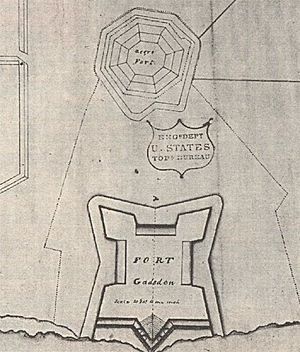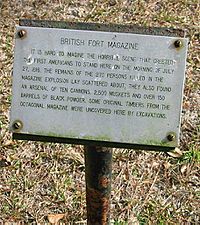Negro Fort facts for kids
Quick facts for kids Battle of Negro Fort |
|||||||
|---|---|---|---|---|---|---|---|
| Part of the Seminole Wars | |||||||
 Map of Fort Gadsden, inside the breastwork that surrounded the original Negro Fort |
|||||||
|
|||||||
| Belligerents | |||||||
Creek |
Fugitive slaves Choctaw |
||||||
| Commanders and leaders | |||||||
| Garçon † | |||||||
| Strength | |||||||
| 267 2 gunboats |
334 | ||||||
| Casualties and losses | |||||||
| 3 killed 1 captured |
334 killed, wounded and captured | ||||||
| The fugitive slave and Choctaw casualties include women and children. | |||||||
Negro Fort was a strong military base built by the British in 1814. It was located in a wild part of what was then Spanish Florida. The fort was meant to help the British attack the United States during the War of 1812. They hoped to help enslaved people in the southern states gain freedom.
The fort was built on a bluff overlooking the Apalachicola River. It was about 15 miles north of where Apalachicola, Florida is today. This fort was the biggest structure between St. Augustine and Pensacola at that time. For many years, trading posts in the area served local Native Americans and fugitive slaves. These were Black people who had escaped from plantations in the American South. They used their farming skills to create farms along the river.
When the War of 1812 ended in 1815, the British left the fort. It soon became a safe place for hundreds of escaped enslaved people. This was a major event before the American Civil War. It showed how armed Black people resisted those who wanted to force them back into slavery.
In 1816, the fort was destroyed in a huge explosion. A "hot cannon ball" hit the fort's gunpowder storage. This event is known as the Battle of Negro Fort. It is also called the Battle of Prospect Bluff or the Battle of African Fort. This battle was the first major fight of the Seminole Wars.
Contents
Building the Fort
The British started building the fort in May 1814. They took over a trading post at the site. By September, the fort had a large square ditch, called a moat, around a big field. A wooden fence, called a stockade, stood 4 feet tall along the moat. It had strong points, called bastions, at its eastern corners.
Inside, there was a stone building for soldiers and a large warehouse. A few hundred feet away was the magazine, where weapons and gunpowder were stored. The British also left behind many tools, uniforms, and boats.
To get more people to join them, the British visited nearby Native American and Black settlements. They gave out guns and uniforms. The Creek people were eager to fight the Americans who had taken their land. They invited Black people to join them. Many enslaved Africans from Spanish Pensacola also came, seeking freedom.
A Safe Place for Escaped People
For many years, enslaved people had found safety in Florida. The Seminole people welcomed them, and the Spanish treated them as free if they became Catholic. This area was like an early version of the Underground Railroad. The Spanish did not try hard to get American enslaved people back.
More and more escaped enslaved people arrived, looking for freedom. They set up farms along the river to feed themselves. These former enslaved people taught the Seminoles how to farm and care for animals. The Creeks, however, were not farmers and often struggled for food.
News of Negro Fort, a strong place with weapons for escaped enslaved people, spread quickly. This made many slave owners in the southern United States very worried.
The Fort's Role in History
After the War of 1812 ended, the British troops were ordered to leave. In May 1815, British commander Edward Nicolls left the fort. He promised his allies he would return.
The Negro Fort continued to fly the British flag. The former Colonial Marines, who were Black soldiers, saw themselves as British citizens. The Spanish still left the escaped enslaved people alone. What was new was that these Black people had military training and many weapons. Nicolls had encouraged them to help others escape slavery and join them.
The number of people at Negro Fort changed often. But its existence as a fortified, armed sanctuary for escaped enslaved people became widely known. Newspapers in the United States were very angry about the fort. They worried it would encourage more enslaved people to run away.
Escaped enslaved people came to Prospect Bluff from as far away as Virginia. The Apalachicola River was used by groups who raided Georgia plantations. They stole livestock and helped enslaved workers escape. To stop this, the U.S. Army decided to build Fort Scott in April 1816.
Supplying Fort Scott was hard. The easiest way was by river, which meant passing directly in front of Negro Fort. In July 1816, boats carrying supplies for Fort Scott were attacked by the fort's defenders. Three sailors were killed, and one was captured. This attack gave the U.S. a reason to destroy Negro Fort.
Andrew Jackson, a powerful general, was asked to deal with the fort. He ordered Brigadier General Edmund P. Gaines to destroy it. The U.S. forces were joined by Creek Indians. They were promised any valuable items found in the fort if they helped. On July 27, 1816, U.S. forces and their Creek allies attacked the fort.
The Battle of Negro Fort

The Battle of Negro Fort was the first big fight of the Seminole Wars. About 330 people were inside the fort. Most were maroons, who were escaped enslaved people. They had ten cannons and many muskets. About thirty Seminole and Choctaw warriors were also there. The fort also held women and children, who were families of the Black fighters.
Before the attack, General Gaines asked the fort's leader, Garçon, to surrender. Garçon refused, saying he had British orders to hold the fort. He raised the British flag and a red flag, meaning they would not give up.
The U.S. Navy gunboats began firing at the fort. The defenders fired back, but they were not skilled with cannons. After several shots, a "hot shot" cannonball from Navy Gunboat No. 154 hit the fort's powder magazine. The explosion was enormous and destroyed the entire fort.
Most of the 334 people inside were killed instantly or died soon after. This included many women and children. The explosion was so loud it was heard over 100 miles away. U.S. troops and their Creek allies then captured the few survivors.
Garçon, the Black commander, and the Choctaw chief were among the survivors. They were given to the Creeks. Any African-American survivors were forced back into slavery. The Creeks took many weapons from the fort's ruins, which made them stronger in the area. The Seminoles, who had fought with the Black people, were weakened. This battle increased tensions between the tribes and helped start the First Seminole War a year later.
After the Battle
Many survivors, including Black people from nearby plantations, moved east. They settled in a place called Nero's Town near the Suwannee River. Others found safety further south in the Tampa Bay area. Some even founded a new town in the Bahamas. A large group of former British Colonial Marines were also moved to Trinidad.
The anger over the fort's destruction fueled continued resistance during the First Seminole War.
See also

